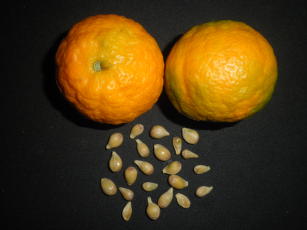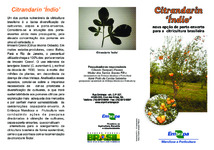Porta-enxerto citrandarin Indio
Citrandarin Indio rootstock

Photo: PASSOS, Orlando
Recommended for use with scions of sweet orange, mandarin and, mainly, acid Tahiti lime trees.
It promotes some characteristics to the scion varieties such as efficiency in terms of productivity and fruit quality, good resistance to gummosis caused by Phytophthora spp. and moderate tolerance to citrus blight and drought.
It comes from the United States Department of Agriculture (USDA), obtained by crossing the ‘Sunki’ mandarin [Citrus sunki (Hayata) hort. ex Tanaka x Poncirus trifoliata (L.) Raf.].
Since it was introduced in Brazil by Embrapa Cassava & Fruits in 1970, it has been evaluated in different ecosystems and different physiographic regions of the country.
HIGHLIGHTS
- It has competitive productivity in relation to traditional rootstocks;
- It has good resistance to gummosis caused by Phytophthora spp.;
- It is moderately tolerant to citrus blight and drought;
- It has high adaptability to tropical conditions;
- Citrandarins are considered a new generation of promising rootstocks around the world.
Where to find:
Essa cultivar é de domínio público e a Embrapa não controla a produção de sementes e mudas realizada por terceiros.
Product: Cultivar Launch year: 2011
Country: Brazil Region: Central-West, Northeast, Southeast State: Distrito Federal, Goiás, Mato Grosso, Mato Grosso do Sul, Alagoas, Bahia, Ceará, Maranhão, Paraíba, Pernambuco, Piauí, Rio Grande do Norte, Sergipe, Acre, Amapá, Amazonas, Pará, Rondônia, Roraima, Tocantins, Espírito Santo, Minas Gerais, Rio de Janeiro, São Paulo, Paraná, Rio Grande do Sul, Santa Catarina Biome: Amazon Rainforest, Cerrado, Atlantic Rainforest, Caatinga, Pampa
Responsible Unit: Embrapa Cassava & Fruits
Participating Units: Embrapa Coastal Tablelands, Embrapa Semi-arid Region
Keywords: Diversificação , Resistência à gomose , Porta-enxerto , Trifoliata, Qualidade de fruto, Indio, Citrandarin





